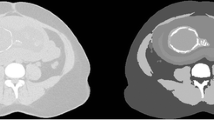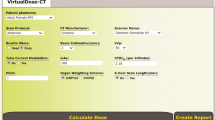Abstract
Objectives
To investigate the effect of patient centring on conceptus radiation dose and image quality in abdominal CT during pregnancy.
Material and methods
Three anthropomorphic phantoms that represent a pregnant woman at the three trimesters of gestation were subjected to a routine abdominal CT. Examinations were performed with fixed mAs (mAsf) and with the automatic exposure control system (AEC) activated. The percent reduction between mAsf and modulated mAs (mAsmod) was calculated. Conceptus dose (Dc) was measured using thermoluminencent dosimeters. To study the effect of misplacement of pregnant women on Dc, each phantom was positioned at various locations relative to gantry isocentre. Image quality was evaluated on the basis of image noise, signal-to-noise ratio, and contrast-to-noise ratio.
Results
The maximum reduction between mAsf and mAsmod was 59.8 %, while the corresponding DC reduction was 59.3 %. DC was found to decrease by up to 25 % and 7.9 % for phantom locations below and above the isocentre, respectively. Image quality deteriorated when AEC was activated, and it was progressively improved from lower to higher than the isocentre locations.
Conclusion
Centring errors do not result in an increase in Dc. To maintain image quality, accurate centring is required.
Key Points
• AEC activation reduces conceptus radiation dose at all gestational stages.
• Patients should be accurately aligned at the gantry isocenter.
• Patient centring deserves increased attention in clinical practice.
• Pregnant patient centring errors do not considerably affect conceptus dose.





Similar content being viewed by others
Abbreviations
- CT:
-
Computed tomography
- AEC:
-
Automatic exposure control
- mAsf :
-
Fixed mAs
- mAsmod :
-
Mean modulated mAs
- DC :
-
Conceptus radiation dose
- TLD:
-
Thermoluminesent dosimeters
- mAsQR :
-
Quality reference milliampere sec
- HU:
-
Hounsfield unit
- SD:
-
Standard deviation
- ROI:
-
Region of interest
- SNR:
-
Signal-to-noise ratio
- CNR:
-
Contrast-to-noise ratio
References
Kennedy A (2000) Assessment of acute abdominal pain in the pregnant patient. Semin Ultrasound CT MR 21:64–77
Wagner LK, Huda W (2004) When a pregnant woman with suspected appendicitis is referred for a CT scan, what should a radiologist do to minimize potential radiation risks? Pediatr Radiol 34:589–590
Goldman SM (2000) Overview of emergency radiological management of the pregnant patient, especially the traumatized pregnant patient. Emerg Radiol 7:198–205
Sharp HT (2002) The acute abdomen during pregnancy. Clin Obstet Gynecol 45:405–413
Shetty MK (2010) Abdominal computed tomography during pregnancy: a review of indications and fetal radiation exposure issues. Semin Ultrasound CT MR 3:3–7
Dauer LT, Thornton RH, Miller DL et al (2012) Radiation management for interventions using fluoroscopic or computed tomographic guidance during pregnancy: A joint guideline of the society of interventional radiology and the cardiovascular and interventional radiological society of Europe with endorsement by the Canadian interventional radiology association. J Vasc Interv Radiol 23:19–32
Damilakis J, Perisinakis K, Voloudaki A, Gourtsoyiannis N (2000) Estimation of fetal radiation dose from computed tomography scanning in late pregnancy. Depth-dose data from routine examinations. Invest Radiol 35:527–533
Damilakis J, Tzedakis A, Perisinakis K, Papadakis AE (2010) A method of estimating conceptus doses resulting from multidetector CT examinations during all stages of gestation. Med Phys 37:6411–6420
Damilakis J, Perisinakis K, Tzedakis A, Papadakis AE, Karantanas A (2010) Radiation dose from multidetector CT during early gestation: A method that allows for variations in maternal body size and conceptus position. Radiology 257:483–489
Goldberg-Stein SA, Liu B, Hahn PF, Lee SI (2012) Radiation dose management: part 2, estimating fetal radiation risk from CT during pregnancy. Am J Roentgenol 198(4):W352–W356
Gilet G, Dunkin JM, Fernandez TJ, Button TM, Budorick NE (2011) Fetal radiation dose during gestation estimated on an anthropomorphic phantom for three generations of CT scanners. Am J Roentgenol 196:1133–1137
Jaffe TA, Neville AM, Anderson-Evans C et al (2009) Early first trimester fetal dose estimation method in a multivendor study of 16- and 64-MDCT scanners and low-dose imaging protocols. Am J Roentgenol 193:1019–1024
Angel E, Wellnitz CV, Goodsitt MM et al (2008) Radiation dose to the conceptus for pregnant patients undergoing multidetector CT imaging: Monte Carlo simulations estimating fetal dose for a range of gestational age and patient size. Radiology 249:220–227
Bredenholler C, Feuerlein U (2006) Somatom Sensation 16 Application Guide. Medical, Siemens
Kalra M, Maher MM, Toth T et al (2004) Techniques and applications of automatic tube current modulation for CT. Radiology 233:649–657
Kalender W, Wolf H, Suess C (1999) Dose reduction in CT by anatomically adapted tube current modulation. II. Phantom measurements. Med Phys 26:2248–2253
McCollough C, Bruesewitz M, Kofler JM (2006) CT dose reduction and dose management tools: Overview of available options. Radiographics 26:503–512
Greess H, Wolf H, Baum U et al (2000) Dose reduction in computed tomography by attenuation-based on-line modulation of tube current: evaluation of six anatomical regions. Eur Radiol 10:391–394
Gies M, Kalender WA, Wolf H, Suess C (1999) Dose reduction in CT by anatomically adapted tube current modulation. I. Simulation studies. Med Phys 26:2235–2247
Papadakis AE, Perisinakis K, Damilakis J (2008) Automatic exposure control in pediatric and adult multidetector CT examinations: a phantom study on dose reduction. Med Phys 35:4567–4576
van Straten M, Deak P, Shrimpton P, Kalender W (2009) The effect of angular and longitudinal tube current modulations on the estimation of organ and effective doses in x-ray computed tomography. Med Phys 36:4881–4889
Matsubara K, Koshida K, Suzuki M, Tsujii H, Matsui O (2008) Comparison between 3-D and z-axis automatic tube current modulation technique in multidetector row CT. Radiat Prot Dosimetry 128:106–111
Namasivayam S, Kalra MK, Pottala KM, Waldrop SM, Hudqins PA (2006) Optimization of z-axis automatic exposure control for multidetector row CT evaluation of neck and comparison with fixed tube current technique for image quality and radiation dose. Am J Neuroradiol 27:2221–2225
Kalra MK, Maher MM, Kamath RS et al (2004) Sixteen- detector row CT of abdomen and pelvis: study for optimization of z-axis modulation technique performed in 153 patients. Radiology 233:241–249
Karla MK, Toth TL (2012) Patient centering in MDCT: Dose effects. In: Tack D et al (eds) Radiation dose from multidetector CT. Springer-Verlag, Berlin, pp 273–278
Toth TL, Zhanyu GE, Daly MP (2007) The influence of patient centering on CT dose and image noise. Med Phys 34:3093–3101
Perisinakis K, Seimenis I, Tzedakis A, Papadakis AE, Damilakis J (2013) The effect of head size/shape, miscentering and bowtie filter on peak patient tissue doses from modern brain perfusion 256-slice CT: how can we minimize the risk for deterministic effects? Med Phys 40(1):011911
Li J, Udayasankar U, Toth TL, Small WC, Karla MK (2008) Application of automatic vertical positioning software to reduce radiation exposure in multidetector row computed tomography of the chest. Invest Radiol 43:447–452
Matsubara K, Koshida K, Ichikawa K et al (2009) Misoperation of CT automatic tube current modulation systems with inappropriate patient centering: Phantom studies. Am J Roentgenol 192:862–865
Papadakis AE, Perisinakis K, Damilakis J (2014) Automatic exposure control in CT: the effect of patient size, anatomical region and prescribed modulation strength on tube current and image quality. Eur Radiol 24:2520–2531
Papadakis AE, Perisinakis K, Oikonomou I, Damilakis J (2011) Automatic exposure control in pediatric and adult computed tomography examinations: can we estimate organ and effective dose from mean mAs reduction? Invest Radiol 46:654–662
Papadakis AE, Perisinakis K, Damilakis J (2007) Angular on-line tube current modulation in multidetector CT examinations of children and adults: the influence of different scanning parameters on dose reduction. Med Phys 34:2867–2874
Acknowledgments
The scientific guarantor of this publication is Prof. John Damilakis. The authors of this manuscript declare no relationships with any companies whose products or services may be related to the subject matter of the article. This study has received funding by the Greek Ministry of Education and Religious affairs, General Secretariat for Research and Technology. No complex statistical methods were necessary for this paper. Institutional review board approval was obtained. The submitted study is not on human subjects. The submitted study is not on animals. No study subjects or cohorts have been previously reported. Methodology: prospective, experimental (phantom study), performed at one institution.
This study was supported by the Greek Ministry of Education and Religious Affairs, General Secretariat for Research and Technology, Operational Program ‘Education and Lifelong Learning’, ARISTIA (Research project: CONCERT).
Author information
Authors and Affiliations
Corresponding author
Rights and permissions
About this article
Cite this article
Solomou, G., Papadakis, A.E. & Damilakis, J. Abdominal CT during pregnancy: a phantom study on the effect of patient centring on conceptus radiation dose and image quality. Eur Radiol 25, 911–921 (2015). https://doi.org/10.1007/s00330-014-3505-2
Received:
Revised:
Accepted:
Published:
Issue Date:
DOI: https://doi.org/10.1007/s00330-014-3505-2




